Functionalized Porous Silica-Based Nano/Micro Particles for Environmental Remediation of Hazard Ions
Abstract
:1. Introduction
2. Porous Silica-Based Nanoparticles Modified by Inorganic Materials
2.1. Silica-Based Nanoparticles Modified by Metal Phosphates
2.1.1. Direct Synthesis of Mesoporous Metal Phosphates via Surfactant Templating
2.1.2. Synthesis of Functional Silica-Based Nanoparticle with Metal Phosphates via Wetness Impregnation
2.1.3. Synthesis of Functional Silica-Based Nanoparticle with Metal Phosphates via a Layer-by-Layer Method
2.1.4. Adsorption Performance of Ion Sorption
2.1.5. Specific Retention Mechanism of Ion Sorption
2.2. Silica-Based Nanoparticles Modified with Molybdophosphate
2.2.1. Synthesis of Functional Silica-Based Nanoparticle with Metal Phosphomolybdate via a Crystallization Sol-Gel Method
2.2.2. Synthesis of Functional Silica-Based Nanoparticle with Metal Molybdophosphoric via an Impregnation Method
2.2.3. Adsorption Performance of Ion Sorption by Silica-Based Nanoparticles Modified with Metal Molybdophosphate
2.2.4. Specific Retention Mechanism of Ion Sorption
2.3. Silica-Based Nanoparticle Modified with Titanate-Based Materials
2.3.1. Synthesis Procedures
2.3.2. Adsorption Performance of Ion Sorption by Silica-Based Nanoparticles Modified with Titanate
2.3.3. Specific Retention Mechanism of Ion Sorption
2.4. Hydrotalcite-Modified Silica-Based Microparticle
2.4.1. Synthesis Procedures
2.4.2. Adsorption Performance of Ion Sorption by Silica-Based Nanoparticles Modified with Hydrotalcite
2.4.3. Specific Retention Mechanism of Ion Sorption
3. Porous Silica-Based Nanoparticles Modified by Organic Materials
3.1. General Synthesis Process of Functional Silica-Based Nanoparticles Modified by Organic Materials
3.2. Specific Ion Sorption by Functional Silica-Based Nanoparticles Modified with Various Organic Groups
3.2.1. Silica-Based Calix {4} Arene-R14 Adsorbent
3.2.2. BTP/SiO2-P Adsorbents
3.2.3. Adsorption of MA (III) and Ln (III), Minor Actinides on Me2-CA-BTP/SiO2-P Adsorbent
3.2.4. Adsorption of Am (III), Ln (III), and Dy (III) on IsoHex-BTP/SiO2-P Adsorbent
3.2.5. Adsorption of 241Am (III) over Y (III) and Ln (III) on Silica/Polymer-Based Isobutyl-BTP/ SiO2-P Adsorbent
3.3. Adsorption of Minor Actinides on Silica/Polymer-Based CA-BTP Adsorbent
4. Concluding Remarks
Author Contributions
Funding
Acknowledgments
Conflicts of Interest
References
- Yang, H.; Alex, K.; Neil, C.; Susan, M.A.; Geoffrey, A.O. Synthesis of oriented films of mesoporous silica on mica. Nature 1996, 379, 703–705. [Google Scholar] [CrossRef]
- Cinzia, A.; Domenico, C.; Claudia, K.; Valerio, V.; Luca, M. Naked nanoparticles in silica nanocapsules: A versatile family of nanorattle catalysts. ACS Appl. Nano Mater. 2018, 1, 1836–1840. [Google Scholar]
- Amr, A.N.; Maged, F.B.; Stéphanie, R.; Aleksander, G.; André, A. Functionalization of MCM-41 with titanium oxynitride deposited via PECVD for enhanced removal of methylene blue. J. Mol. Liq. 2019, 274, 505–515. [Google Scholar]
- Vladimír, Z.; Dáša, H.; Miroslav, A.; Lukáš, Z.; Adriána, Z.; Ondrej, K. Ordered cubic nanoporous silica support MCM-48 for delivery of poorly soluble drug indomethacin. Appl. Surf. Sci. 2018, 443, 525–534. [Google Scholar]
- Vishal, J.M.; Abdi, S.H.R.; Kureshy, R.I.; Khan, N.H.; Santosh, A.; Jasra, R.V. Synthesis and characterization of (S)-amino alcohol modified M41S as effective material for the enantio-separation of racemic compounds. J. Chromatorg. A 2006, 1135, 186–193. [Google Scholar]
- Li, N.; Chen, R.; Miao, J.; Zhou, P.; Yu, H.-B.; Chen, T.-H. Synthesis of single crystal-like hierarchically mesoporous titanosilicate Ti-SBA-1. Chin. Chem. Lett. 2015, 120, 1269–1272. [Google Scholar] [CrossRef]
- Ma, Q.-Q.; Wang, N.; Liu, G.-Z.; Wang, L. Enhanced performance of Pd nanoparticles on SBA-15 grafted with alkyltrialkoxysilane in 2-ethyl-anthraquinone hydrogenation. Micropor. Mesopor. Mater. 2019, 279, 245–251. [Google Scholar] [CrossRef]
- Inagaki, S.; Fukushima, Y.; Kuroda, K. Synthesis of highly ordered mesoporous materials from a layered polysilicate. J. Chem. Soc. Chem. Commun. 1993, 0, 680–682. [Google Scholar] [CrossRef]
- Du, Y.-J.; Cheng, L.-P.; Chen, L.; He, Y.-C.; Wu, Y.-L.; He, S.-S.; Ke, Y.-X. Preparation of sub-2 um large-pore monodispersed mesoporous silica spheres using mixed templates and application in HPLC. Micropor. Mesopor. Mater. 2018, 265, 234–240. [Google Scholar] [CrossRef]
- Corma, A. From microporous to mesoporous molecular sieve materials and their use in catalysis. Chem. Rev. 1997, 97, 2373–2419. [Google Scholar] [CrossRef]
- Moller, K.; Bein, T. Inclusion chemistry in periodic mesoporous hosts. Chem. Mater. 1998, 10, 2950–2963. [Google Scholar] [CrossRef]
- Ying, J.-Y.; Mehnert, C.P.; Wong, M.S. Synthesis and applications of supramolecular templated mesoporous materials. Angew. Chem. Int. Ed. 1999, 38, 56–77. [Google Scholar] [CrossRef]
- Barton, T.J.; Bull, L.M.; Klemperer, W.G.; Loy, D.A.; McEnaney, B. Tailored porous materials. Chem. Mater. 1999, 11, 2633–2656. [Google Scholar] [CrossRef]
- Sayari, A. Catalysis by crystalline mesoporous molecular sieves. Chem. Mater. 1996, 8, 1840–1852. [Google Scholar] [CrossRef]
- Schierbaum, K.D.; Weiss, T.; Thoden Van Veizen, E.U.; Engbersen, J.F.J.; Reinhoudt, D.N.; Göpel, W. Molecular recognition by self-assembled monolayers of cavitand receptors. Science 1994, 265, 1413–1415. [Google Scholar] [CrossRef]
- Zhao, X.-S.; Lu, G.-Q.; Whittaker, A.J.; Millar, G.J.; Zhu, H.Y. Comprehensive study of surface chemistry of MCM-41 using 29Si CP/MAS NMR, FTIR, pyridine-TPD, and TGA. J. Phys. Chem. B 1997, 110, 6525–6531. [Google Scholar] [CrossRef]
- Cinzia, A.; Domenico, C.; Claudia, K.; Valerio, V.; Luca, M. Enhanced Photoacoustic Signal of Passion Fruit-Like Nanoarchitectures in a Biological Environment. J. Phys. Chem. C 2017, 121, 6955–6961. [Google Scholar]
- Fou, A.F.; Ellis, D.; Ferreira, M.; Rubner, M.F. Layer-by-layer molecular self-assembly of conducing polymer heterostructure. Polym. Prepr. 1994, 35, 221. [Google Scholar]
- Gero, D.; Birgit, L.; Klaus, L.; Yuri, L.; Johannes, S. New nanocomposite films for biosensors: Layer-by-layer adsorbed films of polyelectrolytes, proteins or DNA. Biosens. Bioelectron. 1994, 9, 667–684. [Google Scholar]
- Lvov, Y.; Haas, H.; Decher, G.; Möhwald, H.; Michailov, A.; Mtchedlishvily, B.; Morgunova, E.; Vainshtain, B. Successive deposition of alternate layers of polyelectrolytes and a charged virus. Langmuir 1994, 10, 4232–4236. [Google Scholar] [CrossRef]
- Lee, H.; Kepley, L.J.; Hong, H.-G.; Akhter, S.; Mallouk, T.E.J. Adsorption of ordered zirconium phosphonate multilayer films on silicon and gold surfaces. Phys. Chem. 1988, 92, 2597–2601. [Google Scholar] [CrossRef]
- Katz, H.E.; Schilling, M.L.; Chidsey, C.E.D.; Putvinski, T.M.; Hutton, R.S. Quaterthiophenediphosphonic acid (QDP): A rigid, electron-rich building block for zirconium-based multilayers. Chem. Mater. 1991, 3, 699–703. [Google Scholar] [CrossRef]
- Aoki, Y.; Kunitake, T.; Nakao, A. Sol-Gel fabrication of dielectric HfO2 nano-films; Formation of uniform, void-free layers and their superior electrical properties. Chem. Mater. 2005, 17, 450–458. [Google Scholar] [CrossRef]
- Paratt, L.G. Surface studies of solids by total reflection of X-Rays. Phys. Rev. 1954, 95, 359–369. [Google Scholar] [CrossRef]
- Tolstoi, V.P. Synthesis of thin-layer structure by the ionic layer deposition method. Russ. Chem. Rev. 1993, 62, 237–242. [Google Scholar] [CrossRef]
- Keller, S.W.; Kim, H.-N.; Mallouk, T.E. Layer-by-layer assembly of intercalation compounds and heterostructures on surfaces: Toward molecular “Beaker” epitaxy. J. Am. Chem. Soc. 1994, 116, 8817–8818. [Google Scholar] [CrossRef]
- Putvinski, T.M.; Schilling, M.L.; Katz, H.E.; Chidsey, C.E.D.; Mujsce, A.M.; Emerson, A.B. Self-assembly of organic multilayers with polar order using zirconium phosphate bonding between layers. Langmuir 1990, 6, 1567–1571. [Google Scholar] [CrossRef]
- Kleinfeld, E.R.; Ferguson, G.S. Stepwise formation of multilayered nanostructural films from macromolecular precursors. Science 1994, 265, 370–373. [Google Scholar] [CrossRef]
- Kovtyukhova, N.; Ollivier, P.J.; Chiznik, S.; Dubravin, A.; Buzanev, E.; Gorchinskiy, A.; Marchenko, A.; Smirnova, N. Self-assembly of ultrathin composite TiO2/polymer films. Thin Solid Films 1999, 337, 166–170. [Google Scholar] [CrossRef]
- Gawalt, E.S.; Avaltroni, M.J.; Koch, N.; Schwartz, J. Self-assembly and bonding of alkanephosphonic acids on the native oxide surface of titanium. Langmuir 2001, 17, 5736–5738. [Google Scholar] [CrossRef]
- Zhang, J.-N.; Ma, Z.; Jiao, J.; Yin, H.-F.; Yan, W.-F.; Edward, W.H.; Yu, J.-H.; Dai, S. Layer-by-layer grafting of titanium phosphate onto mesoporous silica SBA-15 surfaces: Synthesis, characterization, and applications. Langmuir 2009, 25, 12541–12549. [Google Scholar] [CrossRef] [PubMed]
- Aghayan, H.; Mahjoub, A.R.; Khanchi, A.R. Immobilization of Tin (IV) molybdophosphate onto mesoporous silica SBA-15 and its application on strontium removal from aqueous solution. Appl. Surf. Sci. 2012, 261, 14–20. [Google Scholar] [CrossRef]
- Li, C.-M.; Wei, Y.-Z.; Wang, X.-P.; Yin, X.-B. Efficient and rapid adsorption of iodide ion from aqueous solution by porous silica spheres loaded with calcined Mg-Al layered double hydroxide. J. Taiwan Inst. Chem. E 2018, 85, 193–200. [Google Scholar] [CrossRef]
- Li, C.-M.; Zhang, Y.-S.; Wang, X.-P.; Yin, X.-B.; Luo, N.-N.; Afshin, K.; Wei, Y.-Z. The synthesis and characterization of hydrous cerium oxide nanoparticles loaded on porous silica micro-sphere as novel and efficient adsorbents to remove phosphate radicals from water. Micropor. Mesopor. Mater. 2019, 279, 73–81. [Google Scholar] [CrossRef]
- Zhu, Z.-R.; Yang, W.-M. Characterization and shape-selective catalysis of supported heteropoly acid salts K2.5H0.5PW12O40, (NH4)2.5H0.5PW12O40 and Ce0.83H0.5PW12O40 on MCM-41 mesoporous silica. J. Phys. Chem. C 2009, 113, 17025–17031. [Google Scholar] [CrossRef]
- Chu, W.-L.; Zhao, Z.-B.; Sun, W.-D.; Ye, X.-K.; Wu, Y. Isobutane/butene alkylation over supported heteropoly acid catalysts: I. Influence of the structure of silica. Catal. Lett. 1998, 55, 57–61. [Google Scholar] [CrossRef]
- Liu, Y.Y.; Murata, K.; Inaba, M.; Mimura, N. Selective oxidation of propylene to acetone by molecular oxygen over Mx/2H5−x[PMo10V2O40]/HMS (M=Cu2+, Co2+, Ni2+). Catal. Commun. 2003, 4, 281–285. [Google Scholar] [CrossRef]
- Lefebvre, F. 31P MAS NMR study of H3PW12O40 supported on silica: formation of (SiOH+) (H2PW12O40-). J. Chem. Soc. Chem. Commun. 1992, 0, 756–757. [Google Scholar] [CrossRef]
- Macquarrie, D.J.; Jackson, D.B. Aminopropylated MCMs as base catalysts: A comparison with aminopropylated silica. Chem. Commun. 1997, 18, 1781–1782. [Google Scholar] [CrossRef]
- Liu, C.-J.; Li, S.-G.; Pang, W.-Q.; Che, C.-M. Ruthenium porphyrin encapsulated in modified mesoporous molecular sieve MCM-41 for alkene oxidation. Chem. Commun. 1997, 0, 65–66. [Google Scholar] [CrossRef]
- Cauvel, A.; Renard, G.; Brunel, D.J. Monoglyceride synthesis by heterogeneous catalysis using MCM-41 type silicas functionalized with amino groups. Org. Chem. 1997, 62, 749–751. [Google Scholar] [CrossRef]
- Subba Rao, Y.V.; De Vos, D.E.; Bein, T.; Jacobs, P.A. Practical heterogenisation of an active manganese triazacyclononane epoxidation catalyst via surface glycidylation. Chem. Commun. 1997, 355–356. [Google Scholar] [CrossRef]
- Subba Rao, Y.V.; De Vos, D.E.; Jacobs, P.A. 1,5,7-Triazabicyclo [4.4.0] dec-5-ene Immobilized in MCM-41: A Strongly Basic Porous Catalyst. Angew. Chem. Int. Ed. Engl. 1997, 36, 2661–2663. [Google Scholar]
- Koyano, K.A.; Tatsumi, T.; Tanaka, Y.; Nakata, S.J. Stabilization of mesoporous molecular sieves by trimethylsilylation. Phys. Chem. B 1997, 101, 9436–9440. [Google Scholar] [CrossRef]
- Wei, Y.-Z.; Kumagai, M.; Takashima, Y.; Modolo, G.; Odoj, R. Studies on the separation of minor actinides from high-level wastes by extraction chromatography using novel silica-based extraction resins. Nucl. Technol. 2000, 132, 413–423. [Google Scholar] [CrossRef]
- Wei, Y.-Z.; Zhang, A.-Y.; Kumagai, M.; Watanabe, M.; Hayashi, N. Development of the MAREC process for HLLW partitioning using a novel silica-based CMPO extraction resin. J. Nucl. Sci. Technol. 2004, 41, 315–322. [Google Scholar] [CrossRef]
- Wei, Y.-Z.; Sabharwal, K.N.; Kumagai, M.; Asakura, T.; Uchiyama, G.; Fujne, S. Preparation of novel silica-based nitrogen donor extraction resins and their adsorption performance for trivalent americium and lanthanides. J. Nucl. Sci. Technol. 2000, 37, 1108–1110. [Google Scholar] [CrossRef]
- Chen, Z.; Wu, Y.; Wei, Y.-Z. Preparation of silica-based titanate adsorbents and application for strontium removal from radioactive contaminated wastewater. J. Radioanal. Nucl. Chem. 2016, 307, 931–940. [Google Scholar] [CrossRef]
- Wang, Y.; Wang, X.-X.; Su, Z.; Guo, Q.; Tang, Q.H.; Zhang, Q.-H.; Wan, H.-L. SBA-15-supported iron phosphate catalyst for partial oxidation of methane to formaldehyde. Catal. Today 2004, 93–95, 155–161. [Google Scholar] [CrossRef]
- Olkhovyk, O.; Antochshuk, V.; Jaroniec, M. Benzoylthiourea-modified MCM-48 mesoporous silica for mercury (II) adsorption from aqueous solutions. Colloids Surf. A: Physicochem. Eng. Aspects 2004, 236, 69–72. [Google Scholar] [CrossRef]
- Yatsimirskii, K.B.; Vasilev, V.P. Instability Constants of Complex Compounds; Consultants Bureau: New York, NY, USA, 1960; p. 99. [Google Scholar]
- Waqif, H.S.; Ghannadi, M.M.; Rasheedzad, S. Synthesis and ion exchange properties of cerium (IV) selenite. J. Radioanal. Nucl. Chem. 1984, 84, 239–246. [Google Scholar] [CrossRef]
- Khan, A.A.; Inamuddin, M.; Mezbaul, A. Determination and separation of Pb2+ from aqueous solutions using a fibrous type organic-inorganic hybrid cation-exchange material: Polypyrrole thorium (IV) phosphate. React. Funct. Polym. 2005, 63, 119–133. [Google Scholar] [CrossRef]
- Kolarik, Z.; Udo, M.; Franz, G. Selective extraction of Am (III) over Eu (III) by 2,6-ditriazolyl-and 2,6-ditriazinlpyridines1. Solvent Extr. Ion. Exc. 1999, 17, 23–32. [Google Scholar] [CrossRef]
- Kolarik, Z.; Udo, M.; Franz, G. Extraction of Am (III) and Eu (III) nitrates by 2-6-di-(5,6-dipropyl-1,2,4-triazin-3-yl) pyridines1. Solvent Extr. Ion. Exc. 1999, 17, 1155–1170. [Google Scholar] [CrossRef]
- Chen, Z.; Wu, Y.; Wei, Y.-Z. Cesium Removal from High Level Liquid Waste Utilizing a Macroporous Silica-based Calix [4] arene-R14 Adsorbent Modified with Surfactants. Energy Procedia 2013, 39, 319–327. [Google Scholar] [CrossRef]
- Ning, S.-Y.; Qing, Z.; Wang, X.-P.; Liu, R.-Q.; Wei, Y.-Z. Adsorption behavior of Me2-CA-BTP/SiO2-P adsorbent toward MA (III) and Ln (III) in nitrate solution. Sci. China Chem. 2016, 59, 862–868. [Google Scholar] [CrossRef]
- Liu, R.-L.; Ning, S.-Y.; Wang, X.-P.; Wei, Y.-Z.; Yang, J.-L.; Zhao, Y.-P.; Ding, Y.-Q.; Lan, J.-H.; Shi, W.-Q. Adsorption behavior of actinides and some typical fission products by silica/polymer-based isoHex-BTP adsorbent from nitric acid solution. J. Radioanal. Nucl. Chem. 2015, 303, 681–691. [Google Scholar] [CrossRef]
- Wang, X.-P.; Ning, S.-Y.; Liu, R.-Q.; Wei, Y.-Z. Stability of isoHex-BTP/SiO2-P adsorbent against acidic hydrolysis and γ-irradiation. Sci. China Chem. 2014, 57, 1464–1469. [Google Scholar] [CrossRef]
- Ning, S.-Y.; Zou, Q.; Wang, X.-P.; Liu, R.-Q.; Wei, Y.-Z.; Zhao, Y.-P.; Ding, Y.-Q. Evaluation study on silica/polymer-based CA-BTP adsorbent for the separation of minor actinides from simulated high-level liquid wastes. J. Radioanal. Nucl. Chem. 2016, 307, 993–999. [Google Scholar] [CrossRef]
- Olatunji, M.A.; Khandaker, M.U.; Mahmud, H.N.M.E.; Amin, Y.M. Influence of adsorption parameters on cesium uptake from aqueous solutions? A brief review. RSC Adv. 2015, 5, 71658–71683. [Google Scholar] [CrossRef]
- Chen, C.-C.; Coleman, M.L.; Katz, L.E. Bridging the gap between macroscopic and spectroscopic studies of metal ion sorption at the oxide/water interface: Sr (II), Co (II), and Pb (II) sorption to quartz. Environ. Sci. Technol. 2006, 40, 142–148. [Google Scholar] [CrossRef] [PubMed]
- Carroll, S.A.; Roberts, S.K.; Criscenti, L.J.; O’Day, P.A. Surface complexation model for strontium sorption to amorphous silica and goethite. Geochem. Trans. 2008, 9, 1467–4866. [Google Scholar] [CrossRef] [PubMed]
- Manceau, A.; Schlegel, M.K.; Nagy, L. Charlet, Evidence for the formation of trioctahedral clay upon sorption of Co2+ on quartz. J. Colloid Interface Sci. 1999, 220, 181–197. [Google Scholar] [CrossRef]
- Davis, J.; James, R.; Leckie, J. Surface ionization and complexation at the oxide/water interface I. Computation of electrical double layer properties in simple electrolytes. J. Colloid Interface Sci. 1978, 63, 480–499. [Google Scholar] [CrossRef]
- Sahai, N.; Sverjensky, D.A. Solvation and electrostatic model for specific electrolyte adsorption. Geochim. Cosmochim. Acta 1997, 61, 2827–2848. [Google Scholar] [CrossRef]
- Sverjensky, D.A. Prediction of surface charge on oxides in salt solutions: revisions for 1:1 (M+ L-) electrolytes. Geochim. Cosmochim. Acta 2005, 69, 225–257. [Google Scholar] [CrossRef]
- Sverjensky, D.A. Prediction of the speciation of alkaline earths adsorbed on mineral surfaces in salt solutions. Geochim. Cosmochim. Acta 2006, 70, 2427–2453. [Google Scholar] [CrossRef]
- Sverjensky, D.A.; Sahai, N. Theoretical prediction of single-site enthalpies of surface protonation for oxides and silicates in water. Geochim. Cosmochim. Acta 1998, 62, 3703–3716. [Google Scholar] [CrossRef]
- Prelot, B.; Einhorn, V.; Marchandeau, F.; Douillard, J.-M.; Zajac, J. Bulk hydrolysis and solid-liquid sorption of heavy metals in multi-component aqueous suspensions containing porous inorganic solids: Are these mechanisms competitive or cooperative? J. Colloid Interface Sci. 2012, 386, 300–306. [Google Scholar] [CrossRef]
- Prelot, B.; Lantenois, S.; Charbonnel, M.-C.C.; Marchandeau, F.; Douillard, J.M.; Zajac, J. What are the main contributions to the total enthalpy of displacement accompanying the adsorption of some multivalent metals at the silica-electrolyte interface? J. Colloid Interface Sci. 2013, 396, 205–209. [Google Scholar] [CrossRef]
- Cheng, W.; Ding, C.; Wu, Q.; Wang, X.; Sun, Y.; Shi, W.; Hayat, T.; Alsaedi, A.; Chai, Z.; Wang, X. Mutual effect of U (VI) and Sr (II) on graphene oxides: Evidence from EXAFS and theoretical calculations. Environ. Sci. Nano 2017, 4, 1124–1131. [Google Scholar] [CrossRef]
- Tang, Q.; Wang, K.-T.; Muhammad, Y.; Tong, Z.-F.; Cui, X.-M. Synthesis of highly efficient porous inorganic polymer microsphere for adsorptive removal of Pb2+ from wastewater. J. Clean. Prod. 2018, 193, 351–362. [Google Scholar] [CrossRef]
- Bostick, B.C.; Vairavamurthy, M.A.; Karthikeyan, K.G.; Chorover, J. Cesium adsorption on clay minerals: An EXAFS spectroscopic investigation. Environ. Sci. Nano 2002, 36, 2670–2676. [Google Scholar] [CrossRef]
- Saito, H.H.; Crooks, W.J.; McCabe, D.J.; Nash, C.A. SuperLig 644 Ion Exchange Resin Stability in Nitric Acid at Elevated Temperatures; Westinghouse Savannah River Company: Alken, UK, 2001; p. 34. [Google Scholar]
- Ivanov, V.S. Radiation Chemistry of Polymers; VSP B.V.: Utrecht, The Netherlands, 1992; p. 321. [Google Scholar]
- Kalkwarf, D.R. Safety Evaluation of Cation-Exchange Resins; Report BNWL2391; Pacific Northwest Laboratories: Washington, DC, USA, 1997; p. 32. [Google Scholar]
- Clearfield, A.; Stynes, J.A. The preparation of crystalline zirconium phosphate and some observations on its ion exchange behavior. J. Inorg. Nucl. Chem. 1964, 26, 117–129. [Google Scholar] [CrossRef]
- Alberti, G. Syntheses, Crystalline Structure, and Ion-Exchange Properties of Insoluble Acid Salts of Tetravalent Metals and Their Salt Forms. Acc. Chem. Res. 1978, 11, 163–169. [Google Scholar] [CrossRef]
- Clearfield, A. Role of Ion Exchange in Solid-State Chemistry. Chem. Rev. 1988, 88, 125–148. [Google Scholar] [CrossRef]
- Zhang, B.-L.; Poojary, D.M.; Clearfield, A. Synthesis, characterization, and amine intercalation behavior of zirconium N-(Phosphonomethyl)iminodiacetic acid layered compounds. Chem. Mater. 1996, 8, 1333–1340. [Google Scholar] [CrossRef]
- Bruque, S.; Aranda, M.A.G.; Losilla, E.R.; Olivera-Pastor, P.; Maireles-Torres, P. Synthesis optimization and crystal structures of layered metal (IV) hydrogen phosphates, a-M(HP04)2-H20 (M = Ti, Sn, Pb). Inorg. Chem. 1995, 34, 893–899. [Google Scholar] [CrossRef]
- Ekambaram, S.; Sevov, S.C. Organically templated mixed-valent TiIII/TiIV phosphate with an octahedral-tetrahedral open framework. Angew. Chem. Int. Ed. 1999, 38, 372–375. [Google Scholar] [CrossRef]
- Yu, J.H.; Xu, R.R. Insight into the construction of open-framework aluminophosphates. Chem. Soc. Rev. 2006, 35, 593–604. [Google Scholar] [CrossRef]
- Bhaumik, A.; Inagaki, S. Mesoporous Titanium Phosphate Molecular Sieves with Ion-Exchange Capacity. J. Am. Chem. Soc. 2001, 123, 691–696. [Google Scholar] [CrossRef] [PubMed]
- Mahendra, P.; Kapoor, S.I.; Hisao, Y. Novel zirconium-titanium phosphates mesoporous materials for hydrogen production by photoinduced water splitting. J. Phys. Chem. B 2005, 109, 9231–9238. [Google Scholar]
- Llavona, R.; Suarez, M.; Garcia, J.R.; Rodriguez, J. Lamellar inorganic ion exchangers. Alkali metal ion exchange on α- and γ-titanium phosphate. Inorg. Chem. 1989, 28, 2863–2868. [Google Scholar] [CrossRef]
- Deoliveira, S.F.; Airoldi, C. Some ion exchange properties of amorphous titanium (IV) phosphate. Mikrochim. Acta 1993, 110, 95–101. [Google Scholar] [CrossRef]
- Roca, S.; Airoldi, C. Thermodynamic data of ion exchange on amorphous titanium (IV) phosphate. Thermochim. Acta 1996, 284, 289–297. [Google Scholar] [CrossRef]
- Shin, Y.S.; Arey, B.W.; Wang, C.M.; Li, X.H.S.; Engelhard, M.H.; Fryxell, G.E. Synthesis and characterization of phosphate-coated mesoporous titania and Cd-doping of same via ion-exchange. Inorg. Chem. Commun. 2007, 10, 642–645. [Google Scholar] [CrossRef]
- Lurie, J. Handbook of Analytical Chemistry; Mir Publishers: Moscow, Russia, 1975; p. 105. [Google Scholar]
- Suss, M.; Pfrepper, F. Investigations of the sorption of cesium from acid solutions by various inorganic sorbents. Radiochim Acta 1981, 29, 33–40. [Google Scholar] [CrossRef]
- Krtil, J. Exchange properties of ammonium salts of 12-heteropolyacids-IV: Cs exchange on ammonium phosphotungstate and phosphomolybdate. J. Inorg. Nucl. Chem. 1962, 24, 1139–1144. [Google Scholar] [CrossRef]
- Murthy, G.S.; Sivaiah, M.V.; Kumar, S.S.; Reddy, V.N.; Krishna, R.M. Adsorption of cesium on a composite inorganic exchanger zirconium phosphate-ammonium molybdo-phosphate. J. Radioanal. Nucl. Chem. 2004, 260, 109–114. [Google Scholar] [CrossRef]
- Maji, S.; Basu, S. Separation of 137mBa from its parent 137Cs from an equilibrium mixture using amide incorporated Amberlite IRC-50. Radiochim. Acta 2007, 95, 183–186. [Google Scholar] [CrossRef]
- Mimura, H.; Saito, M.; Akiba, K.; Onodera, Y. Selective uptake of cesium by ammonium molybdophosphate (AMP)-calcium alginate composites. J. Nucl. Sci. Technol. 2001, 38, 872–878. [Google Scholar] [CrossRef]
- Tranter, T.J.; Herbst, R.S.; Todd, T.A.; Olson, A.L.; Eldredge, H.B. Evaluation of ammonium molybdophosphate-polyacrylonitrile (AMP-PAN) as a cesium selective sorbent for the removal of 137Cs from acidic nuclear waste solutions. Adv. Environ. Res. 2002, 6, 107–121. [Google Scholar] [CrossRef]
- Ingale, S.V.; Wagh, P.B.; Sastry, P.U.; Patra, A.K.; Tewari, R.; Singh, I.K.; Phapale, S.B.; Wasnik, R.D.; Rao, A.S.; Gupta, S.C. Nanocrystalline pentaerythritoltetranitrate (PETN) using Sol-Gel process. Def. Sci. J. 2011, 61, 534–539. [Google Scholar] [CrossRef]
- Yavari, R.; Ahmadi, S.J.; Huang, Y.D.; Khanchi, A.R.; Bagheri, G.; He, J.M. Synthesis, characterization and analytical application of a new inorganic cation exchanger-Titanium (IV) molybdophosphate. Talanta 2009, 77, 1179–1184. [Google Scholar] [CrossRef] [PubMed]
- Qureshi, M.; Zehra, N.; Nabi, S.A.; Kumar, V. Comparative study of titanium (IV)-based exchangers in aqueous and mixed solvent systems. Talanta 1973, 20, 609–620. [Google Scholar] [CrossRef]
- Smit, J.; Van, R. Ammonium salts of the heteropolyacids as cation exchangers. Nature 1958, 181, 1530–1531. [Google Scholar] [CrossRef]
- Smit, J.V.R.; Robb, W. Ion exchange on ammonium molybdophosphate-II Bivalent and trivalent ions. J. Inorg. Nucl. Chem. 1964, 26, 509–518. [Google Scholar] [CrossRef]
- Buchwald, H.; Thistlethwaite, W.P. Some cation exchange properties of ammonium 12-molybdophosphate. J. Inorg. Nucl. Chem. 1957, 5, 341–343. [Google Scholar] [CrossRef]
- Sasaki, T.; Watanabe, M.; Komatsu, Y. Layered hydrous titanium dioxide: potassium ion exchange and structural characterization. Inorg. Chem. 1985, 24, 2265–2271. [Google Scholar] [CrossRef]
- Sasaki, T.; Komatsu, Y.; Fujiki, Y. Distribution coefficients of lanthanide elements and some separations on layered hydrous titanium dioxide. J. Radioanal. Nucl. Chem. 1986, 107, 111–119. [Google Scholar] [CrossRef]
- Filipowicz, B.; Pruszynski, M.; Krajewski, S.; Bilewicz, A. Adsorption of 137Cs on titanate nanostructures. J. Radioanal. Nucl. Chem. 2014, 301, 889–895. [Google Scholar] [CrossRef] [PubMed]
- Zhang, M.; Jin, Z.; Zhang, J. Effect of annealing temperature on morphology, structure and photocatalytic behavior of nanotubed H2Ti2O4(OH)2. J. Mol. Catal. A Chem. 2004, 217, 203–210. [Google Scholar] [CrossRef]
- Du, X.; Xu, Y.; Ma, H. Synthesis and characterization of bismuth titanate by an aqueous Sol-Gel method. J. Am. Ceram. Soc. 2007, 90, 1382–1385. [Google Scholar] [CrossRef]
- Wen, P.; Ishikawa, Y.; Itoh, H. Topotactic transformation reaction from layered titanate nanosheets into anatase nanocrystals. J. Phys. Chem. C 2009, 113, 20275–20280. [Google Scholar] [CrossRef]
- Yang, D.; Zheng, Z.; Liu, H. Layered titanate nanofibers as efficient adsorbents for removal of toxic radioactive and heavy metal ions from water. J. Phys. Chem. C 2008, 112, 16275–16280. [Google Scholar] [CrossRef]
- Zou, Y.D.; Wang, P.Y.; Yao, W.; Wang, X.-X.; Liu, Y.H.; Yang, D.-G.; Wang, L.-D.; Hou, J.; Alsaedi, A.; Hayat, T.; et al. Synergistic immobilization of UO22+ by novel graphitic carbon nitride @layered double hydroxide nanocomposites from wastewater. Chem. Eng. J. 2017, 330, 573–584. [Google Scholar] [CrossRef]
- Yao, W.; Wang, X.-X.; Liang, Y.; Yu, S.-J.; Gu, P.-C.; Sun, Y.-B.; Xu, C.; Chen, J.; Tasawar, H.; Alsaedi, A.; et al. Synthesis of novel flower-like layered double oxides/carbon dots nanocomposites for U(VI) and 241Am (III) efficient removal: Batch and EXAFS studies. Chem. Eng. J. 2018, 332, 775–786. [Google Scholar] [CrossRef]
- Yao, W.; Wang, J.; Wang, P.-Y.; Wang, X.-X.; Yu, S.-J.; Zou, Y.-D.; Hou, J.; Hayat, T.; Alsaedi, A.; Wang, X.-K. Synergistic coagulation of GO and secondary adsorption of heavy metal ions on Ca/Al layered double hydroxides. Environ. Pollut. 2017, 229, 827–836. [Google Scholar] [CrossRef]
- Rives, V. Layered Double Hydroxides: Present and Future; Nova Science Pub Inc.: New York, NY, USA, 2002; pp. 75–76. [Google Scholar]
- Duan, X.; Evans, D.-G. Layered Double Hydroxides (Structure and bonding); Springer-Verlag: Berlin, Germany, 2006; p. 234. [Google Scholar]
- Carillo, A.-C.; Griego, D.-A. Hydroxides: Synthesis, Types and Applications; Nova Science Pub Inc.: New York, NY, USA, 2012. [Google Scholar]
- Chubar, N.; Gilmour, R.; Gerda, V.; Micušík, M.; Omastova, M.; Heister, K.; Man, P.; Fraissard, J.; Zaitsev, V. Layered double hydroxides as the next generation inorganic anion exchangers: Synthetic methods versus applicability. Adv. Collioid Interface 2017, 245, 62–80. [Google Scholar] [CrossRef]
- Chen, Z.; Wu, Y.; Wei, Y.-Z. Adsorption characteristics and radiation stability of a silica-based DtBuCH18C6 adsorbent for Sr (II) separation in HNO3 medium. J. Radioanal. Nucl. Chem. 2014, 299, 485–491. [Google Scholar] [CrossRef]
- Chen, Z.; Wu, Y.; Wei, Y.-Z. The effect of temperatures and γ-ray irradiation on silica-based calix {4} arene-R14 adsorbent modified with surfactants for the adsorption of cesium from nuclear waste solution. Radiat. Phys. Chem. 2014, 103, 222–226. [Google Scholar] [CrossRef]
- Panak, P.J.; Geist, A. Complexation and Extraction of Trivalent Actinides and Lanthanides by Triazinylpyridine N-Donor Ligands. Chem. Rev. 2013, 113, 1199–1236. [Google Scholar] [CrossRef] [PubMed]
- Xu, Y.-L.; Kim, S.-Y.; Ito, T.; Hitomi, K.; Kuraoka, E.; Usuda, S.; Ishii, K.J. Study on adsorption behavior of trivalent rare earths onto a macroporous silica-based TODGA adsorbent from high level liquid waste. Nucl. Chem. 2013, 299, 149–155. [Google Scholar] [CrossRef]
- Trumm, S.; Geist, A.; Panak, P.J.; Fanghänel, T. An improved hydrolytically-stable bis-triazinyl-pyridine (BTP) for selective actinide extraction. Solvent Extr. Ion Exc. 2011, 29, 213–229. [Google Scholar] [CrossRef]
- Ning, S.-Y.; Wang, X.-P.; Liu, R.-Q.; Wei, Y.-Z.; He, L.-F.; Tang, F.-D. Evaluation of Me2-CA-BTP/SiO2-P adsorbent for the separation of minor actinides from simulated HLLW. J. Radioanal. Nucl. Chem. 2015, 303, 2011–2017. [Google Scholar] [CrossRef]
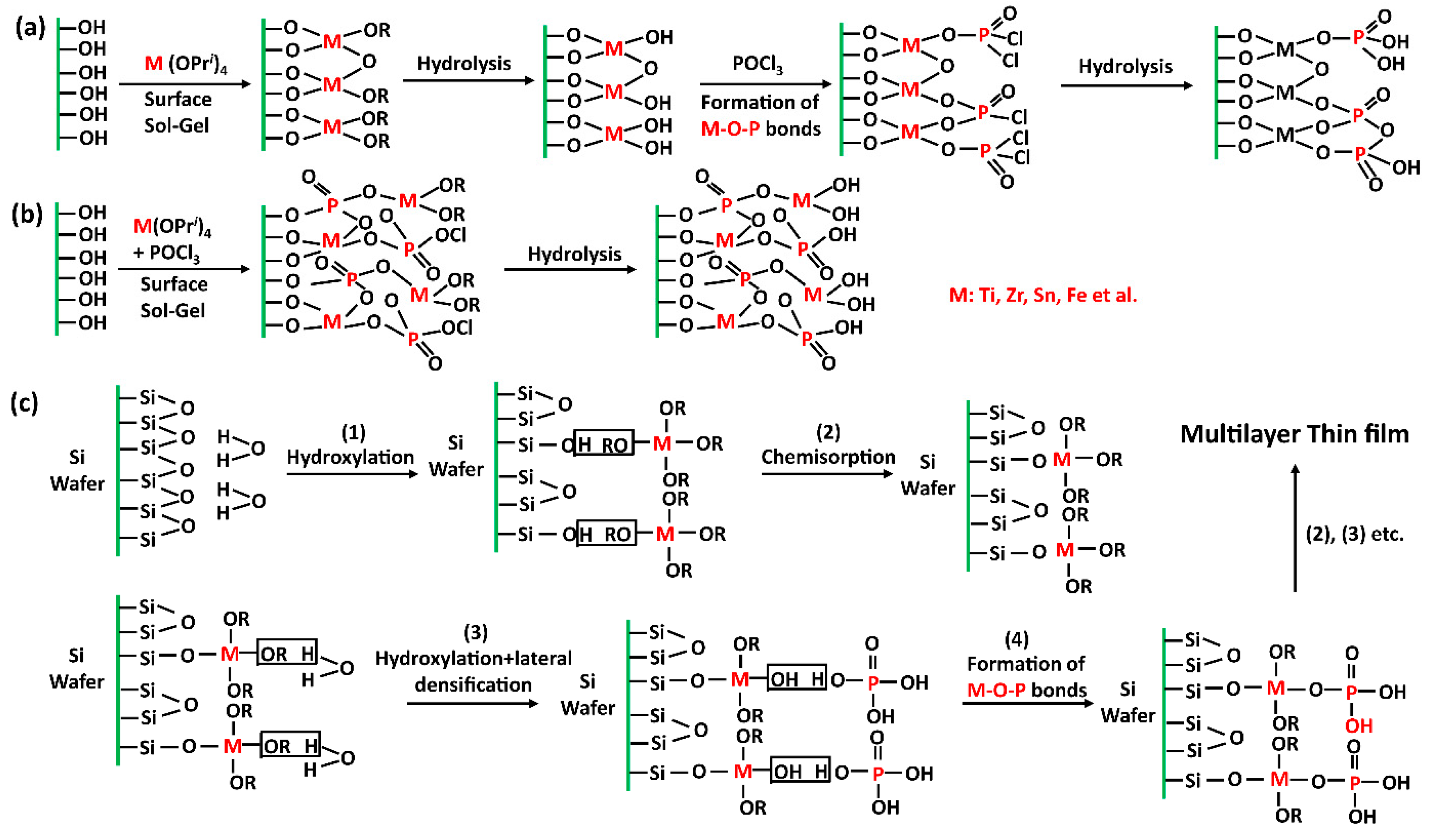
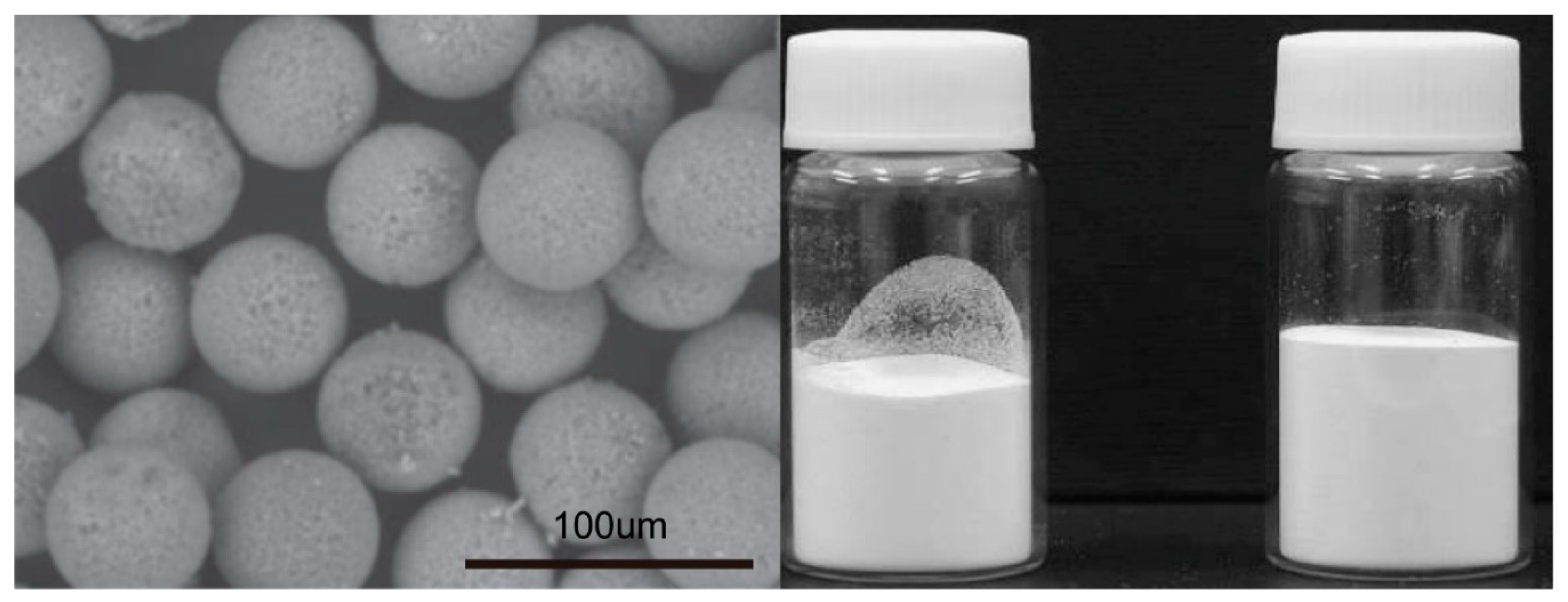
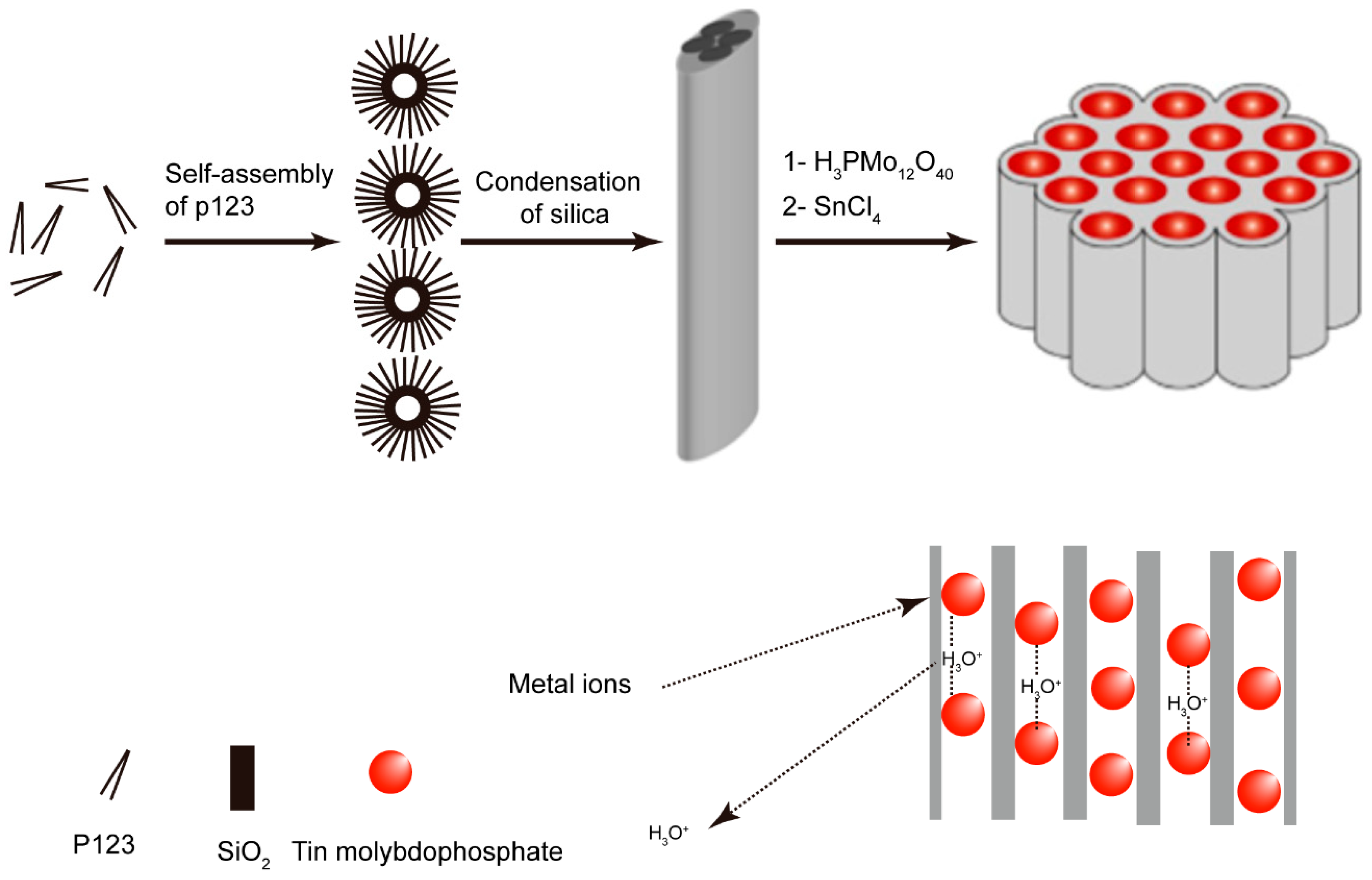







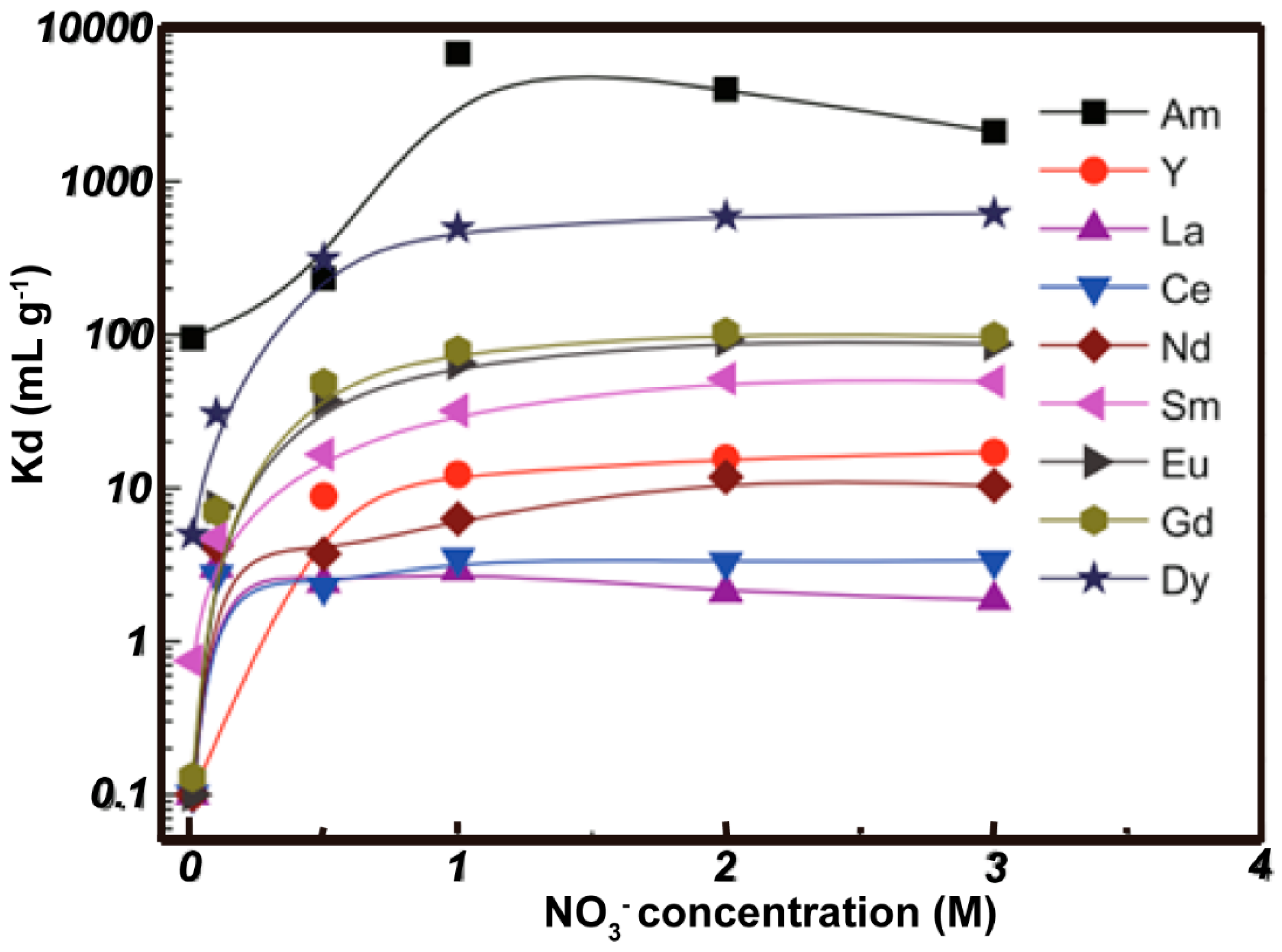


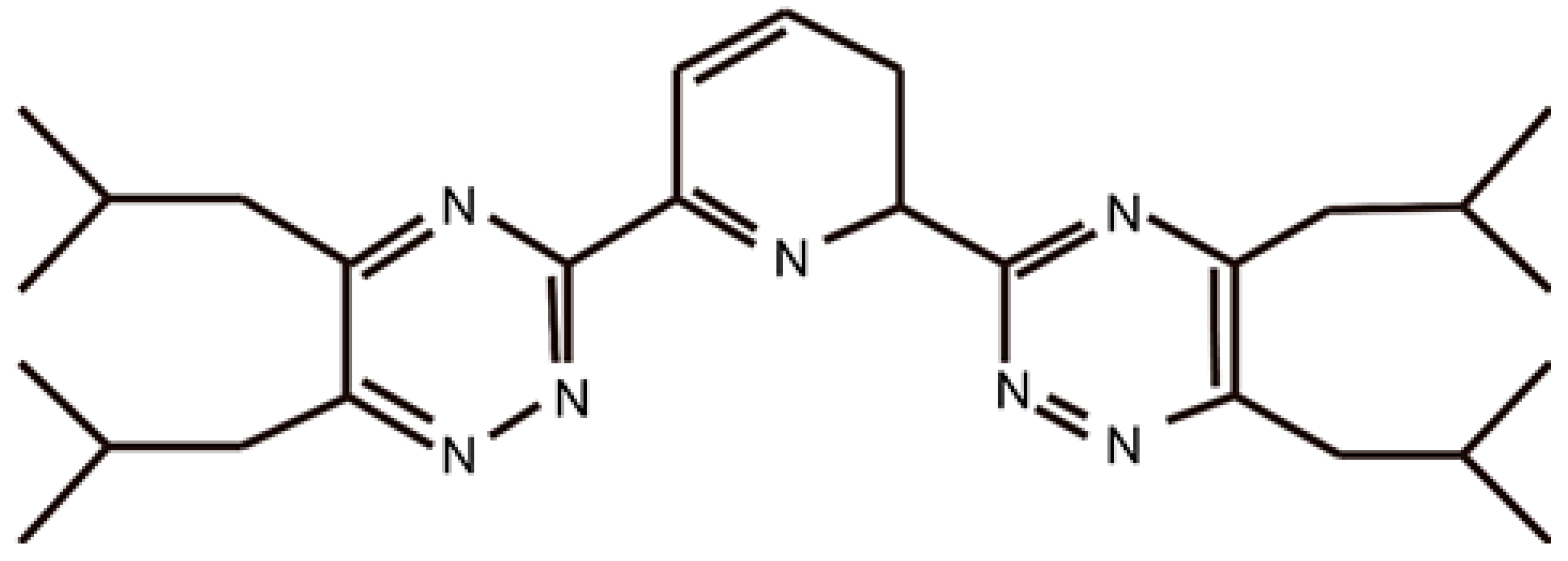
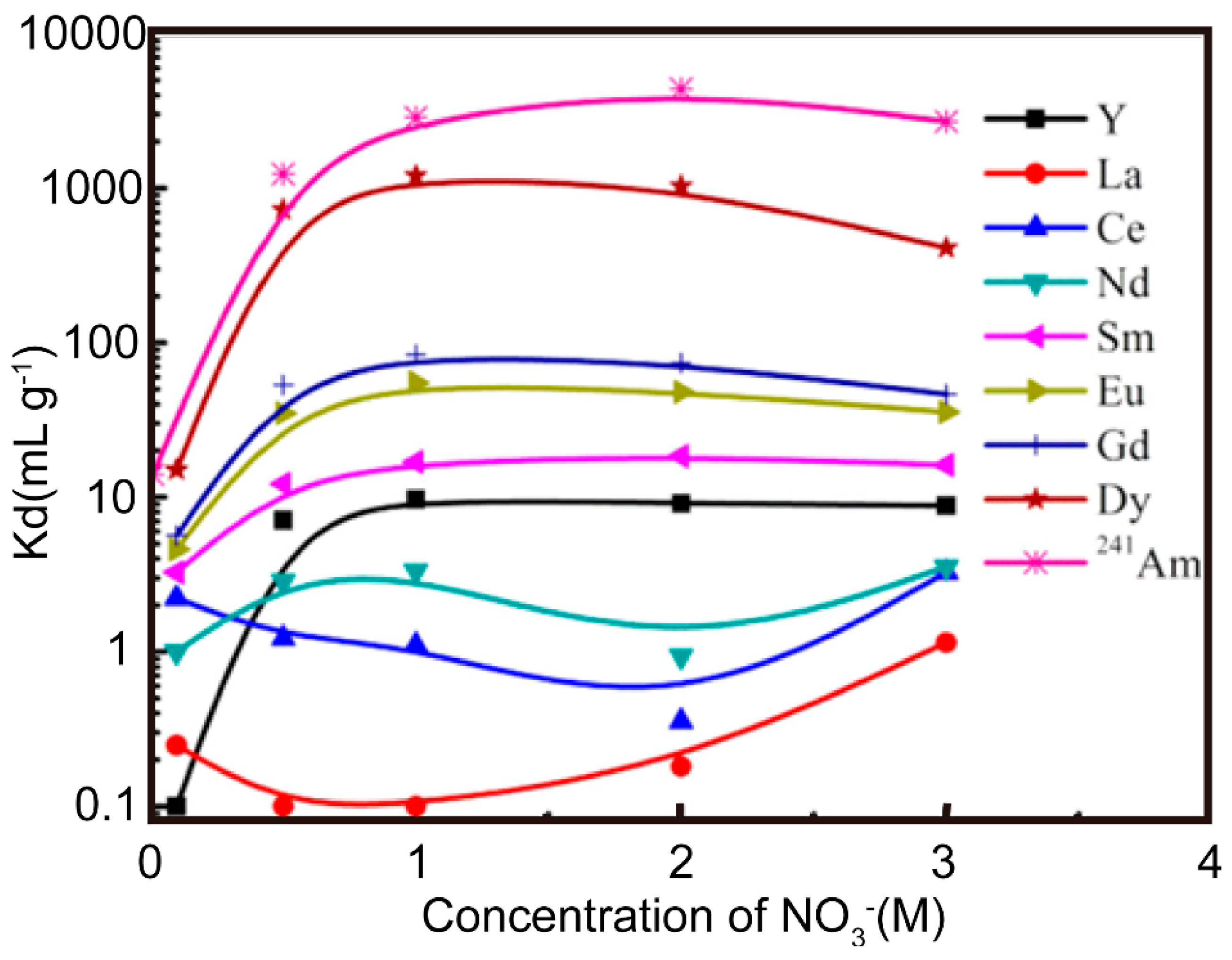


| Sample | Surface Area (m2 g−1) | Particle Size a0 (nm) | Pore Volume (cm−3 g−1) | Pore Diameter (nm) | Reference |
|---|---|---|---|---|---|
| SBA-15 | 773 | 12.1 | 1.16 | 7.8 | [6] |
| MCM-41 | 1268 | 4.196 | 0.92 | 2.5 | [2] |
| MCM-48 | 923 | 50 | 0.63 | 3.8 | [3] |
| M41S | 1064 | 4.196 | 0.942 | 3.54 | [4] |
| SBA-1 | 475 | 11.18 | 1.09 | 3.0 | [5] |
| FSM-16 | 1002 | 4.3 | 0.969 | 3.9 | [7] |
| Silica Sphere | 640 | 75–150 um | 0.29 | 2.8 | [8] |
| Silica-Based Substrate | Inorganic Materials | Loading Methods | Specific Sorption of Reference | Reference |
|---|---|---|---|---|
| SBA-15 | Metal phosphates | Wetness impregnation, Layer-by-layer (LBL) deposition approach | Ni2+, Hg2+, Pb2+ | [31,32,49,50,51] |
| SBA-15 | Metal molybdophosphate | Impregnation method | Cs+, Sr2+, UO22+, Ba2+, Pb2+, Tl+, Zn2+, Rb2+, Zr4+ | [52,53] |
| Silica sphere | Titanate based materials | Surface sol-gel method | Sr2+ | [54,55] |
| Silica sphere | Hydrotalcite | Impregnation method | I− | [32] |
| Silica-Based Substrate | Organic Materials | Loading Methods | Specific Sorption of Ions | Reference |
|---|---|---|---|---|
| Silica sphere | Calix [4] arene-R14 | Impregnation method | Cs+ | [54,56] |
| Silica sphere | Me2-CA-BTP | Impregnation method | MA (III) and Ln (III) | [57] |
| Silica sphere | isoHex-BTP | Impregnation method | Am (III) and Pu (IV) | [58] |
| Silica sphere | isobutyl-BTP | Impregnation method | 241Am (III) over Y (III) and Ln (III) | [59] |
| Silica sphere | CA-BTP | Impregnation method | 241Am (III), 239 Pu (IV), and 99Tc (VII) | [60] |
| Adsorbent | Adsorption Percent/w% | ||||||||||
|---|---|---|---|---|---|---|---|---|---|---|---|
| Cr (III) | Mn (III) | Fe (III) | Co (III) | Ni (III) | Cu (III) | Zn (III) | Cd (III) | Ba (III) | Hg (III) | Pb (III) | |
| Uncalcined sample | 4.06 | 10.52 | 16.54 | 8.08 | 99.97 | 9.27 | 22 | 14.58 | 1.90 | 99.99 | 30.70 |
| Calcined sample | 6.91 | 7.14 | 15.07 | 8.45 | 12.43 | 8.94 | 23.65 | 15.07 | 3.04 | 41.12 | 31.97 |
| Adsorbent | Adsorption Percent/w% | ||||||||||
|---|---|---|---|---|---|---|---|---|---|---|---|
| Cr (III) | Mn (III) | Fe (III) | Co (III) | Ni (III) | Cu (III) | Zn (III) | Cd (III) | Ba (III) | Hg (III) | Pb (III) | |
| Uncalcined sample | 98.25 | 99.82 | 99.96 | 58.3 | 12.51 | 21.99 | 88.32 | 54.43 | 29.97 | 92.42 | 99.99 |
| Calcined sample | 97.51 | 99.96 | 99.98 | 57.9 | 15.57 | 35.37 | 89.20 | 30.20 | 78.80 | 73.88 | 99.94 |
| No. | Metal Separated (ug) | Amount Loaded (ug) | Amount Found (ug) | Total Elution Volume (mL) | Element Used |
|---|---|---|---|---|---|
| 1 | La | 350 | 350 | 35 | H2O |
| Ce | 450 | 410 | 40 | 0.2 mol−1 HNO3 | |
| 2 | Mo | 720 | 720 | 35 | H2O |
| Zr | 240 | 240 | 30 | 0.5 mol−1 HNO3 | |
| 3 | Nd | 1080 | 1050 | 45 | H2O |
| Ce | 400 | 390 | 35 | 0.1 mol−1 HNO3 | |
| 4 | Bi | 1568 | 1490 | 50 | 0.1 mol−1 HNO3 |
| Zn | 200 | 190 | 40 | 0.5 mol−1 HNO3 | |
| 5 | Mo | 960 | 960 | 50 | H2O |
| Pb | 522 | 505 | 25 | 0.5 mol−1 HNO3 | |
| 6 | Li | 105 | 105 | 20 | H2O |
| K | 98 | 90 | 25 | 0.2 mol−1 HNO3 | |
| 7 | Dy | 1625 | 1550 | 45 | H2O |
| Ce | 400 | 380 | 30 | 0.2 mol−1 HNO3 | |
| 8 | Y | 1000 | 950 | 60 | H2O |
| Ti | 510 | 500 | 45 | 0.5 mol−1 HNO3 | |
| 9 | Li | 140 | 140 | 20 | H2O |
| Rb | 440 | 440 | 30 | 0.2 mol−1 HNO3 | |
| 10 | Mo | 1000 | 990 | 55 | H2O |
| Cs | 600 | 660 | 25 | 0.2 mol−1 HNO3 | |
| 11 | Mo | 1000 | 990 | 20 | H2O |
| Sr | 400 | 430 | 20 | 0.1 mol−1 HNO3 |
© 2019 by the authors. Licensee MDPI, Basel, Switzerland. This article is an open access article distributed under the terms and conditions of the Creative Commons Attribution (CC BY) license (http://creativecommons.org/licenses/by/4.0/).
Share and Cite
Li, C.M.; Wang, X.P.; Jiao, Z.H.; Zhang, Y.S.; Yin, X.B.; Cui, X.M.; Wei, Y.Z. Functionalized Porous Silica-Based Nano/Micro Particles for Environmental Remediation of Hazard Ions. Nanomaterials 2019, 9, 247. https://doi.org/10.3390/nano9020247
Li CM, Wang XP, Jiao ZH, Zhang YS, Yin XB, Cui XM, Wei YZ. Functionalized Porous Silica-Based Nano/Micro Particles for Environmental Remediation of Hazard Ions. Nanomaterials. 2019; 9(2):247. https://doi.org/10.3390/nano9020247
Chicago/Turabian StyleLi, Chun Min, Xin Peng Wang, Zi Hao Jiao, Yu Sheng Zhang, Xiang Biao Yin, Xue Min Cui, and Yue Zhou Wei. 2019. "Functionalized Porous Silica-Based Nano/Micro Particles for Environmental Remediation of Hazard Ions" Nanomaterials 9, no. 2: 247. https://doi.org/10.3390/nano9020247





